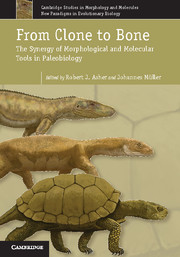Book contents
- Frontmatter
- Contents
- Contributors
- 1 Molecular tools in palaeobiology: divergence and mechanisms
- PART I Divergence
- 2 Genomics and the lost world: palaeontological insights into genome evolution
- 3 Rocking clocks and clocking rocks: a critical look at divergence time estimation in mammals
- 4 Morphological largess: can morphology offer more and be modelled as a stochastic evolutionary process?
- 5 Species selection in the molecular age
- PART II Mechanisms
- 6 Reconstructing the molecular underpinnings of morphological diversification: a case study of the Triassic fish Saurichthys
- 7 A molecular guide to regulation of morphological pattern in the vertebrate dentition and the evolution of dental development
- 8 Molecular biology of the mammalian dentary: insights into how complex skeletal elements can be shaped during development and evolution
- 9 Flexibility and constraint: patterning the axial skeleton in mammals
- 10 Molecular determinants of marsupial limb integration and constraint
- 11 A developmental basis for innovative evolution of the turtle shell
- 12 A molecular–morphological study of a peculiar limb morphology: the development and evolution of the mole's ‘thumb’
- 13 Manus horribilis: the chicken wing skeleton
- Index
- Plate-section
- References
4 - Morphological largess: can morphology offer more and be modelled as a stochastic evolutionary process?
Published online by Cambridge University Press: 05 November 2012
- Frontmatter
- Contents
- Contributors
- 1 Molecular tools in palaeobiology: divergence and mechanisms
- PART I Divergence
- 2 Genomics and the lost world: palaeontological insights into genome evolution
- 3 Rocking clocks and clocking rocks: a critical look at divergence time estimation in mammals
- 4 Morphological largess: can morphology offer more and be modelled as a stochastic evolutionary process?
- 5 Species selection in the molecular age
- PART II Mechanisms
- 6 Reconstructing the molecular underpinnings of morphological diversification: a case study of the Triassic fish Saurichthys
- 7 A molecular guide to regulation of morphological pattern in the vertebrate dentition and the evolution of dental development
- 8 Molecular biology of the mammalian dentary: insights into how complex skeletal elements can be shaped during development and evolution
- 9 Flexibility and constraint: patterning the axial skeleton in mammals
- 10 Molecular determinants of marsupial limb integration and constraint
- 11 A developmental basis for innovative evolution of the turtle shell
- 12 A molecular–morphological study of a peculiar limb morphology: the development and evolution of the mole's ‘thumb’
- 13 Manus horribilis: the chicken wing skeleton
- Index
- Plate-section
- References
Summary
Introduction
If ‘nothing in biology makes sense except in light of evolution’ (Dobzhansky 1973), then evolutionary rates must be the currency exchange rate of biology and species are the currency. Rates of evolutionary change influence ultimate biological factors, such as rates of adaptation, speciation and extinction. These, in turn, determine even higher biological functions, such as ecosystem size and complexity, whose interactions cause truly large-scale biogeographic patterns, such as latitudinal diversity gradients. For example, the higher diversities in the tropics have been hypothesized to be driven by higher rates of mutation and speciation in those climates (Rohde 1992; Allen et al. 2002), faster genetic drift in smaller populations in these regions (Fedorov 1966), and more intense biotic interactions driving higher rates of evolution (Dobzhansky 1950).
Despite their great reach, rates of evolutionary change are determined by proximate drivers – the most basic of which are genetic mutations and developmental variation. Genetic mutations are generally considered random, with their rates driven primarily by stochastic perturbations to the processes of genetic replication, such as copy error, point mutations and unequal recombination. Developmental variation is exposed through the phenotypic plasticity present in all morphological traits (West-Eberhard 2003). Phenotypic plasticity involves different drivers which impart local fitness peaks in different populations (Crispo 2007) or are the result of spurious environmental influences on developmental processes. The latter are epigenetic influences on development that may drive the creation of a continuous or discontinuous set of phenotypic traits (Waddington 1942). Both these processes, mutation and epigenetic developmental variation, provide the ingredients for natural selection. The rate at which the phenotype evolves from these variations is what we are interested in expanding in this chapter. To further complicate matters, the tempo and mode of natural selection upon these proximate heritable variations is determined by a suite of factors, such as population size, body size, generation time and metabolic rate.
- Type
- Chapter
- Information
- From Clone to BoneThe Synergy of Morphological and Molecular Tools in Palaeobiology, pp. 83 - 115Publisher: Cambridge University PressPrint publication year: 2012
References
- 2
- Cited by



